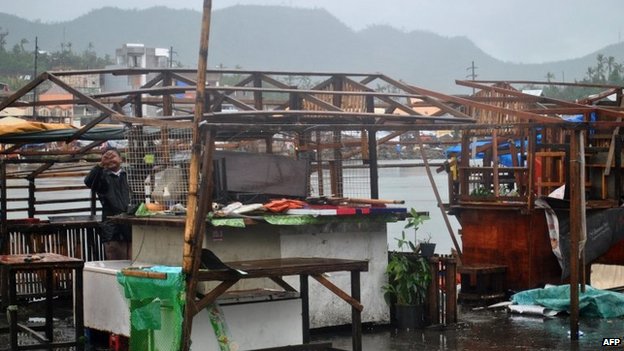Tropical storm Hagupit is heading to Manila, but has been downgraded from a typhoon after crossing the country.

At least three people have been killed by the storm in the south but it caused far less damage than had been feared.
The city of Tacloban, which bore the brunt of last year’s powerful Super Typhoon Haiyan, has emerged from the storm relatively unscathed.
Around a million people had evacuated from vulnerable areas in the south, though many are now heading home.
Albay province, which evacuated more than half its population, has called for those people to go home.
After spending three days at a school in Polangi, families are packing into small military trucks, holding one or two plastic bags with the essentials they brought with them.
They worry about the state in which they’ll find their homes but many are most worried about their rice fields, their only source of income.
One woman reached her house and found it flooded and uninhabitable. For her that means at least one more night in the evacuation centre.
In the capital, residents are preparing for heavy rain and strong winds.
The typhoon is still travelling westwards across the Philippines, and has weakened into a tropical storm, according to the Philippine meteorological authorities.
A government alert on Monday morning stated that residents of the capital and surrounding regions should expect winds of up to 100km/h (62mph) in the next 24 hours, and to prepare for possible flash floods, landslides, and storm surges of up to 2m.
Thousands who live along the coast and riverbanks were evacuated on Monday, reports said. A total of 11.8 million people live in the national capital region.
Manila Mayor Joseph Estrada said the city was prepared and trained for this, but added: It’s the flooding that we are worried about.
Financial markets in the Philippines would be closed on Monday, statements from the Philippine Stock Exchange and the Bankers Association of the Philippines said. Schools were closed, commercial flights were cancelled and civil servants told to stay at home.
Correspondents say Hagupit has been nowhere near as powerful as Typhoon Haiyan – known as Yolanda in the Philippines – which tore through the central Philippines in November 2013, leaving more than 7,000 dead or missing.
In Tacloban, Hagupit blew away roofs and flooded streets, but the area has escaped the wider devastation of last year.
There were no bodies scattered on the road, no big mounds of debris, local woman Rhea Estuna told the Associated Press by phone from Tacloban. Thanks to God this typhoon wasn’t as violent.
Tacloban Mayor Alfred Romualdez told the BBC that the immediate task was assessing damage to the temporary shelters in which some people have been living.
He said that the weather was good now but that high tides were making it harder for waterways to drain, despite work to clear debris.
UN official Orla Fagan told Reuters that a lot of people have begun returning to their homes. In Tacloban this morning, the sun is shining, people just started going back, she said.
At 10:00 on Monday (02:00 GMT), the storm was 20km east of Torrijos, Marinduque, with maximum sustained winds of 105km/h near the centre and gusts of up to 135km/h, government forecaster Pagasa said. It was forecast to move northwest at 10km/h.
At its height, as it approached land on Saturday, gusts of up to 250km/h were recorded,
Authorities say they were better prepared than when Haiyan struck last year, and organised the largest peacetime evacuation in the history of the Philippines.
Justin Morgan, Oxfam country director for the Philippines, told the BBC that a key factor was a greater focus on the dangers of storm surges, meaning people were moved away from coastal areas.
Joey Salceda, governor of Albay province, told the BBC no casualties and only negligible damage had been reported in his province.
He said the storm had been identified as a threat in late November, giving officials time to identify population at risk, evacuate them two days ahead of the storm and prepare food supplies.
Known locally as Typhoon Ruby, Hagupit has nonetheless caused major damage in several towns on the east coast of the Philippines.
The mayor of Dolores, where the storm first made landfall on Saturday, said that 80% of homes there had been destroyed. One resident reportedly died after a tree fell on him.
Two more people – a one-year-old girl and a 65-year-old man – died from hypothermia in the central province of Iloilo, the National Disaster Risk Reduction and Management Council (NDRRMC) said.
A total of 183 flights had been cancelled and five airports closed, the agency said, and there were power outages in 16 provinces.





